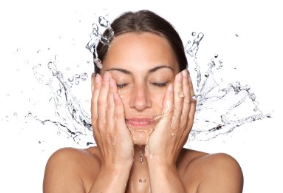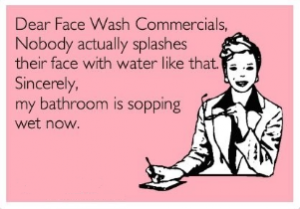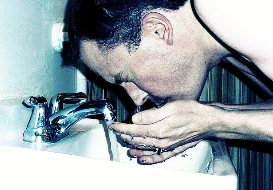 So last night, my cutie-baby-sweetie-pie-wifey-pooh was getting ready for bed, i.e. brushing her teeth, washing her face, etc. and as she was finishing up I walked in and noticed that the counter around the front of the sink was covered with water. This begged the question, do people actually wash their face like you see in every face cleansing/acne preventing/makeup removing commercial ever made?
So last night, my cutie-baby-sweetie-pie-wifey-pooh was getting ready for bed, i.e. brushing her teeth, washing her face, etc. and as she was finishing up I walked in and noticed that the counter around the front of the sink was covered with water. This begged the question, do people actually wash their face like you see in every face cleansing/acne preventing/makeup removing commercial ever made?
You know the one (since they are essentially all the same one), a female with her hair pulled back out of her face, stands in front of a freely flowing faucet. The woman cups her hands together and fills them with water and then tosses it right into her glistening clean face. This is done in slow motion mind you to add to serenity of the whole experience, because slow water hitting you in the face has a feeling of peace, but at regular speed it just looks like you are trying to give yourself a nasal enema. As the slow motion continues we see water splash across and off of the woman’s face . . . and all around the rest of the bathroom.
Whenever I see those commercials, I always want to see what happens next, you know the minute or so after this happens when the lady’s roommate, spouse, lover (whoever really) walks into the bathroom sees water all over place and asks, “Why do you keep washing your face like that? Now get the mop and clean this mess up!”
 Apart from the slow motion tossing of water, I think how the way the lady has closed her eyes is the other thing I struggle with in these commercials. Their eyes are always lightly and serenely closed, like in those commercials where people are smelling a hot cup of their morning coffee. I get that the point of marketing is to sell, not just a product, but an idea or image associated with the product, but these commercials lead me to think that clearly the marketing gurus in charge have never ever seen a woman wash her face using their product. Here is process as I’ve witnessed it over the years:
Apart from the slow motion tossing of water, I think how the way the lady has closed her eyes is the other thing I struggle with in these commercials. Their eyes are always lightly and serenely closed, like in those commercials where people are smelling a hot cup of their morning coffee. I get that the point of marketing is to sell, not just a product, but an idea or image associated with the product, but these commercials lead me to think that clearly the marketing gurus in charge have never ever seen a woman wash her face using their product. Here is process as I’ve witnessed it over the years:
- Start with the extended duration of running the faucet to make sure the water temperature is the perfect face washing temperature.
- Tilt at the waist so the face is directly over the sink.
- Cup hands and fill will water.
- Squeeze eyes tightly shut then place face into hand cupped water.
- Release the cupped hands so the water (mostly) falls back into the sink.
- With eyes still tightly closed, fumble around the counter until you find the product you will be using to lather up your face.
- Lather up your face. Note: Eyes are still tightly closed.
- Fumble around the counter to find a dry washcloth.
- Dampen washcloth with the perfect-face-washing-temperature tap water (still running).
- With eyes still tightly shut, begin vigorously scrubbing face with the moist washcloth.
- Drop washcloth in or somewhere around the sink.
- Cup hands again and fill with water.
- Bring hands full of water up to your face, eyes still tightly closed, and let the water drop off face and (mostly) back into the sink.
- Repeat previous step until all the sudsy face product is removed from the face.
- Stand up straight and, with eyes still shut tight, feel around behind you until you come across a dry towel.
- Use towel to dab remaining moisture from face.
- Face the mirror and blink repeatedly until eyes adjust to the lights.
- Return towel to rack.
- Locate discarded washcloth and use it to wipe down all random puddles around the sink.
Congratulations, your face is now clean; it is officially time for bed.
 See in all of that there is no serene face, or lightly closed eyes. It is a vigorous scrubbing process with a product that warns you not to get it in your eyes, or mouth for that matter, which is why the face is always tightly squinched up during the entire face washing ordeal.
See in all of that there is no serene face, or lightly closed eyes. It is a vigorous scrubbing process with a product that warns you not to get it in your eyes, or mouth for that matter, which is why the face is always tightly squinched up during the entire face washing ordeal.
I’m not expecting this Smirk to inspire any change in the marketing world, but it would be nice if they occasionally tried to exercise a little creativity when it comes to washing your face. You know a fresh, maybe even clean, perspective on the matter.
Image Sources:
Google Images, keywords: washing face and face washing commercials.
Copyright © 2012 Richard Timothy

